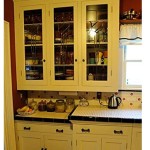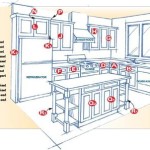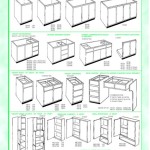Should You Put Tile Under Your Kitchen Cabinets?
Kitchen renovations often involve decisions that balance aesthetics, practicality, and budget. One such decision is whether to install tile flooring under kitchen cabinets. While seemingly minor, this choice can have long-term implications for both the look and functionality of the kitchen. This article explores the arguments for and against tiling under cabinets, enabling homeowners to make informed decisions based on their specific needs and circumstances.
One of the primary arguments for tiling under kitchen cabinets is the potential for a more unified and aesthetically pleasing look. Installing tiles across the entire floor creates a seamless, continuous surface, avoiding transitions between different flooring materials. This can make the kitchen appear larger and more cohesive, particularly beneficial in open-plan layouts. Furthermore, if cabinets are ever removed or relocated, the existing tile floor will already be in place, saving the cost and effort of patching or replacing flooring sections.
From a practical standpoint, tiling under cabinets provides a protective layer against moisture damage. Kitchen spills and leaks are inevitable, and a tiled surface offers better protection against water infiltration than subflooring or other exposed materials. This can prevent costly repairs caused by water damage to the subfloor, especially in areas prone to spills around the sink and dishwasher. The durability of tile also makes it a suitable choice for high-traffic areas like kitchens, withstanding wear and tear from foot traffic and dropped objects better than some other flooring options.
However, there are also several arguments against tiling under the cabinets. The most prominent is the added cost and labor involved. Tiling under the cabinets requires more materials and time, increasing the overall project expenses. This cost might not be recouped during resale, as the tiled area is hidden from view. Furthermore, if a significant plumbing issue arises under the cabinets requiring access to the subfloor, the existing tile will need to be removed and replaced, potentially incurring additional costs and disruption.
Another consideration is the potential difficulty of leveling the floor. Kitchen cabinets require a level surface for proper installation and function. If the subfloor is uneven, achieving a level surface with tile underneath can be more challenging, potentially necessitating additional subfloor preparation work. This can further add to the project's complexity and cost. Moreover, heavy appliances such as refrigerators and ovens placed on top of the tiled area can exert significant pressure, potentially leading to cracking or damage to the tiles over time, especially if the subfloor isn’t adequately prepared.
The issue of trapped moisture is also a concern. While tile provides a waterproof surface, water can still seep through grout lines or damaged tiles and become trapped beneath the cabinets. This trapped moisture can create a breeding ground for mold and mildew, posing health risks and potentially damaging the cabinets and subfloor. Proper sealing of grout lines and regular maintenance can mitigate this risk, but it remains a factor to consider.
Furthermore, if the kitchen layout is likely to change in the future, tiling under the cabinets might be unnecessary. If cabinets are expected to be removed, relocated, or resized, the existing tile underneath may no longer align with the new layout. This can result in an awkward appearance with visible cut lines or mismatched tile patterns. In such cases, it might be more practical to install the tile only in the visible areas and use a different, less expensive material under the cabinets.
The decision of whether to tile under kitchen cabinets also depends on the type of cabinets being installed. Stock cabinets, which have a fixed size and configuration, might be less adaptable to future layout changes, making tiling underneath a more viable option. However, custom or semi-custom cabinets offer greater flexibility for future modifications, potentially making it more practical to avoid tiling under them.
Subfloor condition is another crucial factor to consider. If the existing subfloor is in good condition and level, tiling under cabinets presents fewer challenges. However, if the subfloor is uneven, damaged, or requires significant repairs, addressing these issues before tiling is essential. This can increase the project's complexity and cost, potentially influencing the decision of whether to tile under the cabinets.
Finally, budget constraints play a significant role. Tiling under cabinets adds to the material and labor costs, which may not be feasible for all budgets. If cost is a major concern, opting for a more affordable flooring solution under the cabinets might be a more practical approach. Alternative materials like plywood or vinyl flooring can provide adequate protection while keeping the project within budget limitations.

Should You Install Tile Floor Before Or After Cabinets

Can You Replace Kitchen Flooring Without Removing Cabinets

Should You Install Tile Floor Before Or After Cabinets

Should You Install Tile Floor Before Or After Cabinets

Should You Install Tile Floor Before Or After Cabinets

Let S To Tile Or Not Hi Sugarplum

Where Should My Kitchen Backsplash Start And Stop

Where To Put Things In Kitchen Cabinets How Organize Your Declutter And Launch Professional Organizing Business

4 Super Easy Steps To Fill The Gap Between Cabinet And Floor Abbotts At Home

5 Ways To Protect Your Kitchen Cabinets Sink From Water Damage Dry Force
Related Posts








